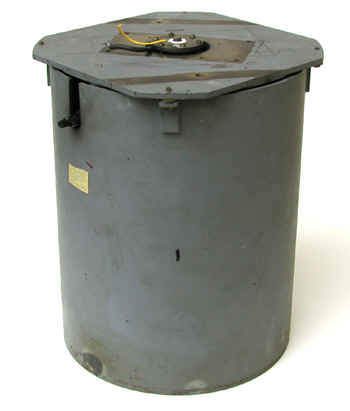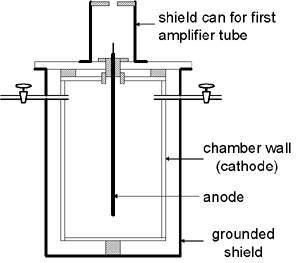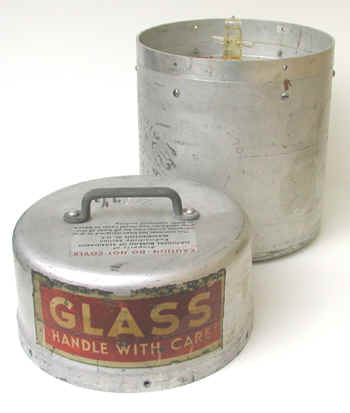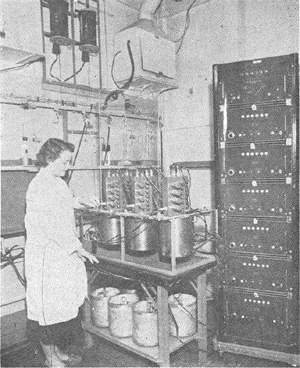Ion Chamber from the National Bureau of Standards for Radon Analysis in Breath Samples

This chamber was built at the National Bureau of Standards (NBS) as a means to quantify the radon in the exhaled breath of radium dial workers—the levels of radon could then be used to estimate the radium-226 activity in the skeleton. The chamber was also used to measure the ambient radon concentrations in the workplace.
Evacuated glass flasks (and rubber balloons) were shipped inside aluminum containers from the NBS to the facility where the air or breath samples were required. A worker would exhale into one of the balloons and then the exhaled air would be transferred into the evacuated flask. This method was easy to perform but the use of rubber or neoprene for collecting samples was sometimes discouraged because of its tendency to absorb some of the radon in the sample. When the transfer had been accomplished, the shipping container was sealed and sent back to the NBS for analysis.
It was best if the sample was collected in an uncontaminated room, preferably with all the windows open. In addition, the individual providing the sample should not have participated in radioactive work for the previous three or more hours.


A four-liter volume was chosen for the chamber so that it could accommodate a two-liter breath sample plus the volume of nitrogen required to help carry the sample. The operating voltage was 500 to 1000 volts. As indicated in the accompanying diagram, the actual ionization chamber is housed inside a secondary chamber that acted as an electrostatic shield and protected the workers handling the equipment from the high voltage.
At the Bureau, the sample was passed through a catalytic converter to remove any oxygen. The converter, a heated (550°C) cylinder packed with copper, converted oxygen to H2O. The water was then removed by passing the air through a desiccant. Finally, the sample made its way to the ionization chamber where it was counted overnight. Unlike most ion chambers that operate in the current mode, this system operated in the pulse mode. The pulses were produced by the alpha particles emitted by radon and its decay products: polomium-218 and polonium-214. Pulses produced by beta particles or gamma rays would be too small to register.


The photograph to the right shows a rack of six ion chambers in operation. The sample collection flasks, still inside the shipping containers, can be seen on the bottom shelf of the table. The scalers (“traffic recorders”) are stacked in the rack on the right side of the photo. The catalytic converters (“furnaces”) are mounted against the wall in the upper left.
This photograph (above left) shows a container used by the NBS to ship the sample flasks. The top of the flask can be seen projecting out of the lower portion of the container.
Donated by the National Bureau of Standards courtesy of Ron Colle and Larry Lucas.
References
- Curtiss and Davis 1943 and Preparation, Maintenance and Application of Standards of Radioactivity by Mann and Seliger.
- Curtiss, L. and Davis, F. A., Counting Method for the Determination of Small Amounts of Radium and Radon, J. of Research of the Nat. Bureau. Stand., 31: 181-195; 143.
